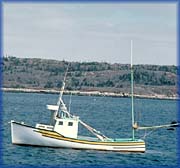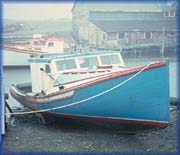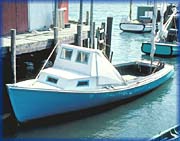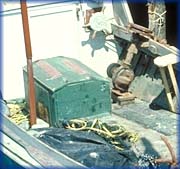|
The Automobile Engine
 he make-and-break engine motorized
the inshore fishery and made it safer, more efficient, and less laborious.
The adoption of the automobile engine further revolutionized the inshore
fishery and made it far more versatile and efficient. Perhaps most
significantly, the automobile engine made possible the changes in hull design
that led to the accepted classic Cape Islander shape. he make-and-break engine motorized
the inshore fishery and made it safer, more efficient, and less laborious.
The adoption of the automobile engine further revolutionized the inshore
fishery and made it far more versatile and efficient. Perhaps most
significantly, the automobile engine made possible the changes in hull design
that led to the accepted classic Cape Islander shape.
|

|

Stephanie Dawn,
a Classic Cape Island Boat
Stephanie Dawn, a classic Cape Island boat at East Dover, Halifax County.
She was built at Sandy Point, Shelburne County in 1976. She is a typical
latter-built wooden hull. This boat has a raised forecastle and is fitted
with an after mast for a riding or steadying sail.
(Courtesy: David Walker)
|
|
While the make-and-break engine had taken the inshore fishermen into the
mechanical age, the automobile engine gave them increased versatility. The
old, single- or twin-cylinder make-and-break engines were heavy, and their
power was limited, with none to spare for auxiliary equipment. Soon after the
automobile became common, surplus engines from scrapped or wrecked vehicles
began to make their way aboard small boats. Their conversion to efficient
sea-going power units soon followed. Auto engines had much more horsepower
per pound of weight, and though physically larger, they did not weigh much
more than the make-and-breaks. Their installation in the narrow boats gave a
new speed and versatility unknown previously. Higher power at higher
revolutions made the retention of automobile gearboxes necessary. The reverse
gear was also required, as formerly engines were reversed simply by halting
their motion and re-starting them in the opposite direction like a
reciprocating steam engine.
|
|
Changes in Hull Design
 he increased size of the new
engines with the gearboxes made a number of changes in hull design desirable.
Boats were built wider, and the after run was made flatter and broader as the
sterns were given wide transoms. This long flat run of the underwater hull
prevented the hulls from "squatting" under power and gave much more space
within the cockpit for fishing gear or lobster traps. The larger, more
sea-kindly hulls allowed the fishermen to go farther offshore into deeper
waters. he increased size of the new
engines with the gearboxes made a number of changes in hull design desirable.
Boats were built wider, and the after run was made flatter and broader as the
sterns were given wide transoms. This long flat run of the underwater hull
prevented the hulls from "squatting" under power and gave much more space
within the cockpit for fishing gear or lobster traps. The larger, more
sea-kindly hulls allowed the fishermen to go farther offshore into deeper
waters.
|

|

Cape Island Boat
A nameless, single, unbroken, shear Cape Island boat at Port Maitland,
Yarmouth County. Note the curved-top cuddy on the forecastle.
(Courtesy: David Walker)
|
|
Automobile engines had remote controls, and by fitting a steering wheel
adjacent to the front of the engine, the helmsman could move forward,
enabling him to fish directly overside for lobsters. This move made a shelter
necessary for protection. Boats were next fitted with a short forward deck
space with a small raised shelter or "pilot house" and then later a windshield.
With time, the forecastle deck was raised and fitted with a cud or cuddy, which
allowed for seating and a small stove to be fitted below deck. The windshield
was eventually fitted with a roof stretching aft over the helmsman, and this
developed in turn into a small deckhouse or "winterhouse" if it was
portable.
The overall appearance of such craft by the beginning of World War II had
assumed the essence of the popularly accepted characteristics of the Cape
Island boat. These features were retained until wood was replaced by
fibreglass.
|

|

Never Tell, a Lunenburg County Boat
Never Tell, a Lunenburg County boat built on Eastern Points
Island in 1953. The canvas dodger gives extra protection on the port side.
(Courtesy: David Walker)
|
|
Mechanical Auxiliary Equipment
 he first piece of mechanical
auxiliary equipment, a lobster trap hauler, was devised and fitted shortly
after the automobile engine was adopted. This novel convenience was fashioned
from another automobile cast-off, the rear axle. One side was cut off at the
differential, and the unit sat on the closure plate so the remaining axle stood
vertical. A pulley on the cut-off drive shaft was connected to the fan-belt
pulley at the forward end of the engine, and an idler pulley controlled by a
lever put it in motion. On the top of the vertical axle a small wooden capstan
head was fitted to haul trap lines, relieving much of the lobsterman's
labour. he first piece of mechanical
auxiliary equipment, a lobster trap hauler, was devised and fitted shortly
after the automobile engine was adopted. This novel convenience was fashioned
from another automobile cast-off, the rear axle. One side was cut off at the
differential, and the unit sat on the closure plate so the remaining axle stood
vertical. A pulley on the cut-off drive shaft was connected to the fan-belt
pulley at the forward end of the engine, and an idler pulley controlled by a
lever put it in motion. On the top of the vertical axle a small wooden capstan
head was fitted to haul trap lines, relieving much of the lobsterman's
labour.
This device was followed by many other auxiliary mechanical winches and fittings
which helped adapt the hulls to various methods of fishing. The adaptive re-use
of automobile or truck mechanical cast-off parts led to the development of novel
winches for hauling small trawl nets, reeling in long line trawls, activating
jigs, and pulling and retrieving scallop drags. The inventive appropriation of
technology made the Cape Islander a proven and dependable vessel for exploiting
the disparate inshore fishery. As these adaptations were proven effective, larger
boats were built to range further afield, but their style remained essentially
unchanged.
|

|

Improvised Lobster-Trap Hauler
On the open, starboard side of Never Tell, shown in this illustration, is
a lobster-trap hauler made from an automobile rear axle.
(Courtesy: David Walker)
|
|



